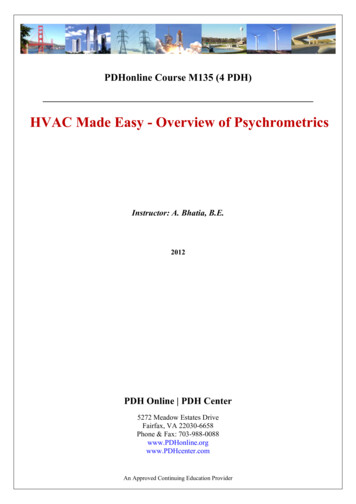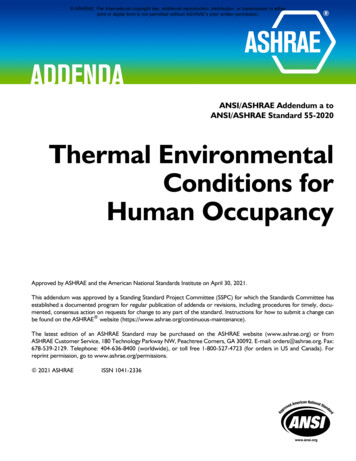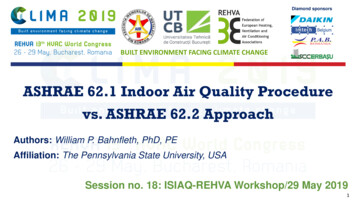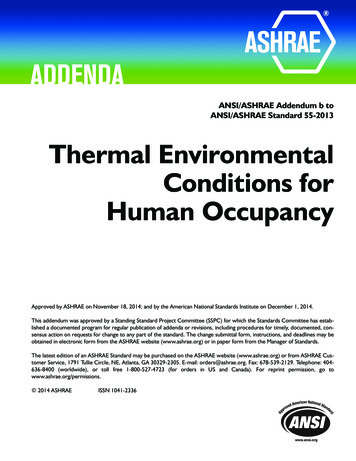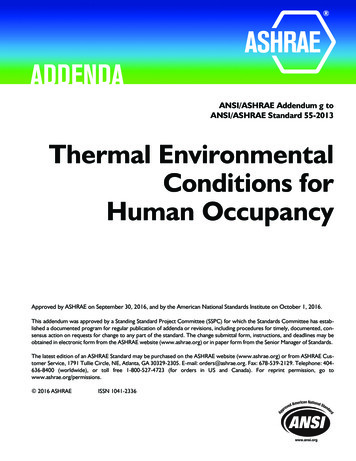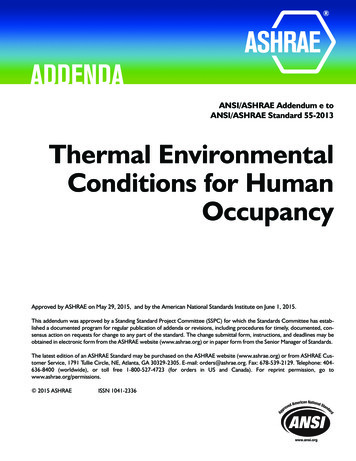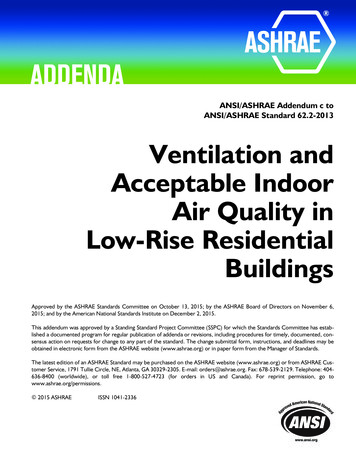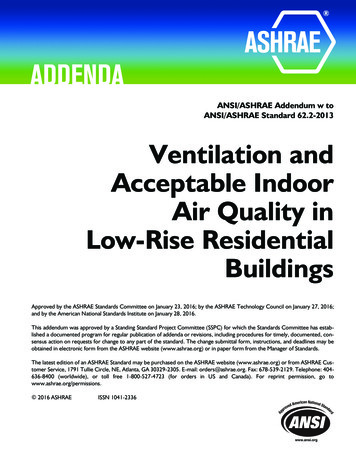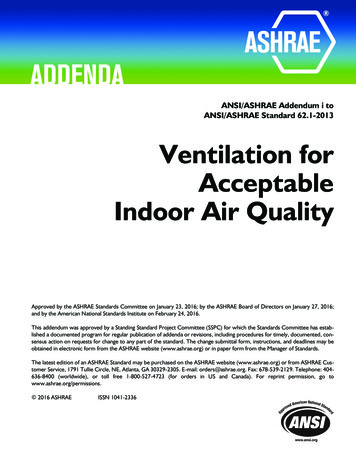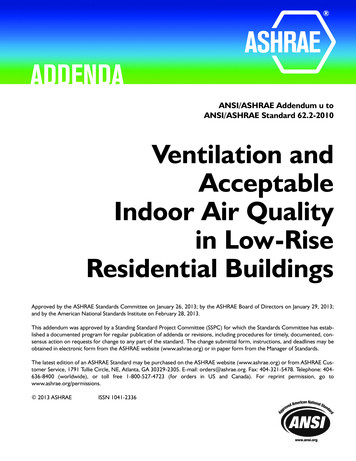
Transcription
PsychrometricsScott Laurila Senior Application EngineerGreenheck Fan CorporationSchofield, Wisconsin1
AAgendad Properties of AirThe PsychrometricyChartApplications MixedAir Cooling Dehumidification Energy Recovery2
CCourseObjObjectivesti At the completion of this session, you should be able to use aPsychrometric Chart to: IdentifyId if theh propertiesi off airi at a givenistate conditiondi i Illustrate the performance characteristics of basic heatingand cooling processes Demonstrate how the use of Energy Recovery devices canreduce heating and cooling loads in building designs3
PPsychrometricshti Psychrometricshi isi theh scienceidealingd li withi h theh physicalh i llaws or air – water mixtures Important in the design of HVAC systems as numerous airproperties can be found over a broad range of conditions4
PPropertiesti off AirAi Properties of Air Dry-Bulb TemperatureWet-Bulb TemperatureDew-Point TemperatureRelative HumidityHumidity RatioEnthalpyIf any two of the above properties are known, thePsychrometric Chart can be used to find the remainingproperties5
Properties of Air Dry-bulb temperature is thetemperature read from astandard thermometer Wet-bulbWetbulb temperature is readfrom a thermometer with thebulb covered by a wet wick Representative of the sensibleheat energy at the givencondition"Sling Psychrometer"Difference between dry-bulband wetwet-bulbbulb represents thedryness of air6
PPropertiesti off AirAi Dew-point temperature is thetemperature at whichmoisture leaves the air andcondenses on objectsWhen the dry-bulb, wet-bulb,and dew-point temperaturesare equal, the air is saturated Fog occurs when the air issaturated7
PPropertiesti off AirAi Relative humidity is the measure of how much moisture the airis holding versus how much moisture the air can hold at agiven dry-bulbdry bulb temperature Expressed as a percentage As the dry-bulbdry bulb temperature increases, the amount ofmoisture the air can hold increasesAmountt off moistureAittheth airi isi holdingh ldiRelative Humidity Amount of moisture the air can hold8
PPropertiesti off AirAi Humidity Ratio is a measure of the weight of water in a givenamount of air AlsoAl referredfd to as SSpecificifi HumidityH idi Can be expressed in grains 7,0007 000 grains equals one pound of waterPoundsPd off moistureitHumidity Ratio Pounds of dry air9
Th PThePsychrometricht i ChChartt10
S t ti CurveSaturationCSaturation Curve11
D B lb TDry-BulbTemperaturet12
W t B lb TWet-BulbTemperaturet13
DDew-PointP i tTTemperaturet14
R l ti HRelativeHumidityidit15
Humidity Ratio16
SSensibleibl anddLLatentt tEEnergy Sensible Energy is the heat that causes changes in the air's drybulb temperatureLLatentEnergyEi theish heath associatedi d withi h phasehchange.hItI isirepresentative of changes in the air's moisture content with nog to the dry-bulbytemperaturepchangeEnthalpy is the total energy in a given amount of air at itspresent conditionsEnthalpy (h) Sensible Energy Latent Energy17
E th lEnthalpy18
PPsychrometricht i ChChartt RReconstructedt t d19
Example:93 F DB, 65 F WBE th lEnthalpyFind:Relative Humidity 24.0%Dew-Point 50.9 FHum. Ratio 66.8 grains/lb dry airEnthalpy 32.9 Btu/lbWet-BulbDew-PointHumidity RatioRelative HumidityDry-Bulb20
Ai DAirDensityit CCorrectionsti Do NOT forget about elevation!Above 2,000 feet elevation, the air density is reduced byapproximatelyi t l 33.6%6% per every 11,000000 ffeettA change in air density also changes the physical andthermodynamic properties of air-waterair water mixtures21
PPsychrometrichti PProcesses Air Conditioning MixedAir Cooling Coils Reheat Calculations Energy Recovery SensibleDevices Total Enthalpy Devices22
Psychrometric ProcessesExample Processes EvaporativeCoolingSteamHumidificationSensible: SideSide-to-sideto sideLatent: Up & downCoolingg 100110Dry Bulb Temp.23
Use the ASHRAE indoord i conditionsdesigndi ito helph l withihprocess calculationsASHRAE IIndoordDDesigni CConditionsditiSummer Indoor Design75 F, 50% RHWinter Indoor Design72 F, 35% RH24
Mi d AiMixedAir CConditionsditi Step 1: Identify outdoor condition, indoor condition, andventilation rate (% outside air)Step 2: Draw a straight line between the outdoor andindoor conditionsStep 3: Draw a straight line between points 1 and 225
Mi d AiMixedAir EExamplelOutdoor Air: 95 F DB/75 F WBRoom Air: 75 F DB, 50% RHVentilation: 25% Outdoor Air95 F x 00.2525 2323.75 F75 F75 F x 0.75 56.25 FMixture 80 F26
C li PCoolingProcess EExamplelCondenserHighg PressureCompressorExpansion ValveEEvaporatortLow Pressure27
C li CCoolingCoilil PProcessesCapacity (Btu/hr) 4.5 x SCFM x Δh 1 CoolingC li TonT 12,00012 000 Btu/hrB /hCapacity (Tons) 4.5 x SCFM x Δh / 12,00028
C li ECoolingExercisei Exercise 2: A customer wants to cool 4,000 SCFM ofoutside air from 93 F DB / 65 WB to 50 F saturated airFind the following parameters for 50 F saturated air:PropertyValueUnitsRelative Humidity100%Dew Point50 FHumidity Ratio64.8Enthalpy22grains / lb dry airBtu / lb dry airWhat is the changeg in enthalpypy from 93DB/65WB to50DB/50WB? Δh 10.9 Btu / lb dry air D tDeterminei theth coolingli tonnagetrequiredi d ini thisthi process. Capacity 16.4 Tons29
Deh midification w// ReheatDehumidification Introducing cold, saturated air directly into an occupiedspace may be too cool for occupant comfortReheat can be used to bring the air to a space-neutralconditionReheat MethodsElectric Heat Hot Water Coil Hot Gas Reheat 30
C li PCoolingProcess EExamplelCondenserHighg PressureCompressorExpansion ValveEEvaporatortLow Pressure31
H t GasHotG ReheatR h tDischarge LineReheatCoilAir Conditions After Reheat Coil:65 F DBT/56 F WBT (50% RH)Air Conditions After Evaporator:50 F DBT / 50 F WBTEvaporatorSupply Air32
EEnergyRRecovery33
Traditional HVAC System34
35
Wh EWhyEnergy RRecovery? Economic Benefits Reduced Initial Costs ReducedR d d OperatingOti CostsC tASHRAE Standards & Guidelines ASHRAE 62.1 – 2010 – Ventilation for Acceptablepindoorair quality ASHRAE 90.1 – 2010 – Energy Standard for Buildings ASHRAE 189189.11 – Standard for Design of HighPerformance Green Buildings36
ASHRAE Standard 62“Ventilation for Acceptable Indoor Air Quality” Must supply fresh outdoor air to occupied spaces tominimize the potential for adverse health effects.Typical ventilation rates: 15 CFM per person for Classrooms 17 CFM per person for OfficesSteven Taylor – Taylor Engineering37
ASHRAE 9090.1-20101 2010 Exhaust Air Energy Recovery (6.3.6) Supply air is greater than 5000 CFM 70% or more of supply is outdoor air (3500 CFM)Energy recovery system shall have a total effectivenessof greater than 50%38
ASHRAE Climate Zones39
ASHRAE 90.1-2010Table 6.5.6.1 Energy Recovery Requirement (IP)40
ASHRAE 189.1“Standard for Design of High-Performance Green Buildings”www.ashrae.org/greenstandardTable 7.4.3.8 Energy Recovery Requirement (IP)41
EEnergyRRecovery BBasici TTerms Sensible Energy Recovery transfers only sensible energy(no moisture) Also referred to as heat recoveryyTotal Energy Recovery transfers both sensible and latentenergyEffectiveness refers to the efficiency of the energyrecovery device (expressed as a percentage) Sensible effectiveness Total effectiveness42
SSensibleibl HHeatt RRecovery Sensible Heat Recoveryy Aluminum fixed plate Run-around coils Heat-pipe heatexchangers SensibleS ibl wheelsh l (no(desiccant)Transfers sensible energygyonly (no moisture transfer)43
SSensibleibl PlPlatet HRV44
Sensible Energy Recovery Sensible Energygy recoveryymoves the outdoor air drybulb temperature laterallytoward the room dry bulbtemperature1801608014012070Outdoor AirHeatExchangers60100805060Room Air40403020203040506070Dry Bulb Temp.809010011045
T t l EnergyTotalERecoveryR Total Energygy Recoveryy Enthalpy wheels Enthalpy plates (or cores)Transfers sensible energythrough the mediaTTransfersf latentl t t energythrough a desiccant (wheel) ormolecular transfer (core)46
EEnergyRRecoverySummer Operation w/ Rotary Wheel47
Total Energy Recovery Total energy recoveryshifts OA point towardsRA pointTotal effectiveness 60-80%60 Room Air404030202030405060708090100110Dry Bulb Temp.48
P tL dCPart-LoadConditionsditi49
Energygy Recoveryy and CoolinggPotentialEnergy Savings50
Winter OperationpSupply AirDry Bulb 54 FHumidity 31 grains/lb.Room Air(to be exhausted)Dry Bulb 72 FHumidity 41grains/lbgrains/lb.Outdoor AirDry Bulb 0 FHumidity 2grains/lb.Exhaust AirDry Bulb 18 FHumidity 12grains/lb.51
Winter OperationSensible vs. Total ERV52
Energy Recovery and Frost Possibility of condensation forming whenever a warm, moistair stream comes in contact with a cold surfaceAlways consider frost control methods in when winter designtemps drop below 55 FF53
Winter Exhaust Air ProcessSensible vs. Total ERVSensibleTotal54
Question?55
R iReview Psychrometric Charts are useful tool forunderstandingg HVAC pprocesses Easilyfind properties of air across numerousconditions Allows us to plot, predict, and calculate theheating and cooling capacities An understanding of psychrometrics is thefoundation of energy recovery56
THANK YOU!57
Psychrometric Chart to: Id if h i f i i di iIdentify the properties of air at a given state condition Illustrate the performance characteristics of basic heating andcoolingprocessesand cooling processes Demonstrate how the use of Energy Recovery devices can reduce heating and cooling loads in building designs 3
